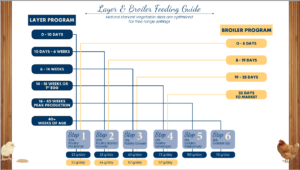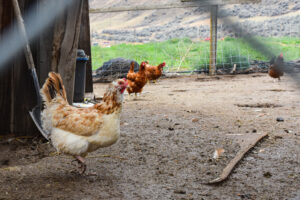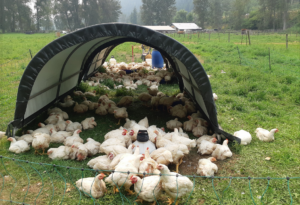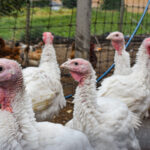4.4 Poultry
Layer Hens
Chickens are the quintessential farm animal, and fresh eggs are hard to beat! Eggs are one product that your customers will buy on a regular basis from you, and help sell products from your other enterprises. Hens lay more eggs in the Summer than the Winter, so calculate how many dozen eggs you want to sell on average each week, or how many chickens you want to keep (or have space for).
When choosing an area for them to live, keep in mind that chickens will eventually eat all of the plants and scratch the ground so nothing will grow well if they are kept in the same space. They could be grazed on fields and moved into a coop for the Winter.
Equipment needed:
- Shelter (2-3 square feet of space per full-sized chicken in the coop) – includes nesting boxes, perches, wood shavings or other bedding for the floor, and sufficient square footage of space. This shelter can be stationary, or you can pasture your layers with an Egg Mobile, a moveable coop. They will need insulated/heated space in the winter to prevent frostbite.
- Brooder space for chicks from 0-3 weeks of age – heat lamps, small feed troughs, chick waterers, thermometer, wood shavings, vitamin powder for their water, apple cider vinegar, and vaccinations for the chicks (you order them vaccinated or not)
- Outdoor space (8-10 square feet of space per chicken in the outdoor run)
- Waterer
- Feeder
- Feed (which changes depending on their age), oyster shells
- Egg cartons
- Refrigerator to store eggs

You can buy two-day old chicks from hatcheries in BC and Alberta, and pick them up at the post office. They are fine without food or water for a first few days of life as they have nutrients from their eggs, but they need to be given water and food as soon as you bring them home. In their water, add vitamin powder, and apple cider vinegar for the first two weeks. They don’t start laying eggs until they are 18 weeks old, so consider their feed costs before they bring in a profit.
As chicks, they will need to be kept safe in a brooder, similar to broiler chickens. Once their feathers have all come in about 6 weeks, then they can go outside more and will be safer in the elements.
They will lay eggs consistently until they are about 1.5 years old, then egg production decreases until they are about 6 or 7 years old when they stop laying. Egg laying is largely dependent on the length of the day, and most hens will stop (or decrease) laying when they receive fewer than 12 hours of daylight. You can add lights to the coop to mimic sunlight.

Broiler Chickens
Raising Cornish Cross chickens for meat takes only 8 weeks from the time you get the chicks to the slaughter date. This short turn-around time works well for your cash flow, and you can time it well around the rest of your farm operations. In Kamloops, you can have 2 rounds of raising chickens, one in the Spring and one in the Fall. You can start them in April, ready in June, or starting in August and ready in October.
Be careful though, book your slaughter date BEFORE you buy the chicks from your local abattoir, then time it with the slaughter date. The delivery dates are very flexible, but the slaughterhouses book up early, so call in January to book the dates.
Equipment needed:
- Shelter (2-3 square feet of space per full-sized chicken in the coop) – This shelter can be stationary, or you can pasture your broilers in a moveable shelter.
- Brooder space for chicks from 0-3 weeks of age – heat lamps, small feed troughs, chick waterers, thermometer, wood shavings, vitamin powder for their water, apple cider vinegar, and vaccinations for the chicks (you order them vaccinated or not)
- Outdoor space (8-10 square feet of space per chicken in the outdoor run)
- Waterers
- Feeders
- Feed, which changes depending on their age (see feed schedule above)
- Access to a local abattoir
- Refrigerator/freezer to store meat
You can buy two-day old chicks from hatcheries in BC and Alberta, and pick them up at the post office. They are fine without food or water for a first few days of life as they have nutrients from their eggs, but they need to be given water and food as soon as you bring them home. In their water, add vitamin powder, and apple cider vinegar for the first two weeks.
Once you know the slaughter date, you can market them early and pre-sell them, then you only have to refrigerate the chickens for a few hours until your customers can pick them up. If you need to store them for several weeks/months while you sell them, you can buy some fridges or deep freezers depending on your scale of production, then work your way up to large scale refrigeration (e.g. a freezer trailer). People also like to buy them refrigerated (not frozen) so they can cut them up. The abattoir will only give you whole chickens, and without a commercial kitchen and food safety permit, you can only sell whole birds.
If you can find a butcher to prepare the meat, customers really like to buy boneless, skinless chicken breasts, which are sold at a much higher price per pound than whole birds, and might offset some of the costs of your operation. You will also need lots of freezer space if you are selling them in pieces, then you might have leftover legs or thighs.
Brooder Phase/Chicks (0-3 weeks old)
- Chicks need to be kept at a consistent temperature, in a space with no drafts but also with some air flow. It can be tricky to figure out a space, so take detailed records to keep improving your system.
- If you choose, you can use a deep bedding system, and continually add more wood shavings as needed which becomes an anaerobic compost system and doesn’t smell.
- Feed chicks continuously, or at least four times a day. In the water add vitamin powder, and apple cider vinegar for the first two weeks.
- After they are 3 weeks old (when most of their feathers come in), they can be moved outside
In the field (3-8 weeks old)
- Make sure the pasture space isn’t too big, you might have a problem with predators.
- If you pasture them in a field, you can build “chicken tractors” (closed pens), or have them on open field and move them around with moveable, electrified poultry netting. While they are on the pasture, they need shelter. One option that Dezmond used was a Shelter Log Run-In shelter (12x20ft per 125 chickens) and used two for 250 chickens, put together shade and coverage for rain. A sprinkler was added on top of the shelter to keep them cool during the hot summer.

Turkeys
- Book your slaughter date in January with your local abattoir if you want to time your turkeys for Thanksgiving or Christmas dates. If you can market them early and pre-sell them, then you don’t have to refrigerate/freeze the turkeys for more than a few hours until your customers can pick them up.
- Make sure they have lots of space to not convert it to bare land. Turkeys love living with chickens, as they both eat the same thing.
- Turkeys can range a bit in the orchard, eat weeds and bugs, and help the fruit trees too.
- Turkeys
Further Reading
- BC Poultry Production Information
- BC Chicken Marketing Board – New Entrants
- Regenerative Agriculture: A practical whole systems guide to making small farms work by Richard Perkins


